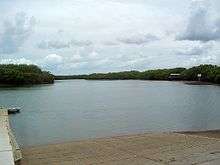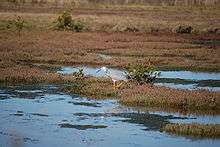Boondall Wetlands
The Boondall Wetlands lie on the edge of Moreton Bay in the Brisbane suburb of Boondall between Nudgee Beach and Shorncliffe, in south-east Queensland, Australia. The wetlands are preserved within the Boondall Wetlands Reserve which was preserved in 1990 and covers more than 1100 hectares of internationally significant wetlands.[1]
.jpg)


Description
The Boondall Wetlands are Brisbane's largest wetlands. They became protected under the Ramsar Convention on 22 October 1993.[2] The northern boundary is marked by Cabbage Tree Creek and the Kedron Brook floodway marks the southern limits of the wetlands. Nudgee Creek and the Gateway Motorway both pass through the wetlands, with the later providing road access to the Boondall Wetlands Environment Centre. Facilities in the park includes elevated walkways, bikeways and bird watching platforms.
Flora and fauna
The reserve supports various vegetation communities including tidal flats, mangroves, freshwater lakes, salt marshes, casuarina forests, melaleuca swamplands, grasslands, open forests, woodlands and remnant rainforest.[3]
The wetlands support a diversity of wildlife, including invertebrates, fish, reptiles, amphibians, mammals and more than 190 species of birds.[4] Many of the birds are international migratory shorebirds which breed during the northern summer months in Arctic regions,[2] making Boondall Wetlands globally important for these long-distance visitors.[5] The wetlands form part of the Moreton Bay and Pumicestone Passage Important Bird Area.[6]
Some of the migratory species include the Mongolian plover, eastern curlew, grey-tailed tattler and bar-tailed godwit.[7] Other birds seen the reserve include pied oystercatchers, beach thick-knees, darters, little black cormorants, white-faced herons, Australian white ibis, great egrets, grass owls, whistling kites and brahminy kites.[7]
Facilities
Camping in not permitted in the reserve.[7] There is a visitor information centre and walking tracks, including a boardwalk through mangroves. There is a bird hide on Nundah Creek and a boat ramp on Nudgee Beach Road.[7]
References
- "Celebrate World Wetlands Day at Boondall Wetlands". Brisbane City Council. 27 February 2005. Archived from the original on 14 March 2011. Retrieved 19 February 2011.
- McBride, Frank; et al. (2009). Brisbane 150 Stories. Brisbane City Council Publication. pp. 292–293. ISBN 978-1-876091-60-6.
- "Boondall Wetlands". Brisbane City Council. Archived from the original on 1 November 2010. Retrieved 30 November 2010.
- "Birds of Boondall Wetlands Checklist". Brisbane City Council. Archived from the original on 15 March 2011. Retrieved 30 November 2010.
- "Boondall Wetlands Reserve". Tourism Queensland. Retrieved 30 November 2010.
- "IBA: Moreton Bay & Pumicestone Passage". Birdata. Birds Australia. Archived from the original on 6 July 2011. Retrieved 6 June 2011.
- Shilton, Peter (2005). Natural Areas of Queensland. Mount Gravatt, Queensland: goldpress. pp. 148–150. ISBN 0-9758275-0-2.
External links
![]()